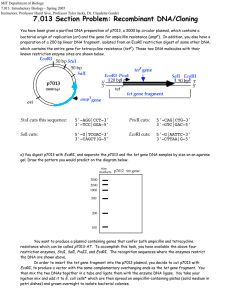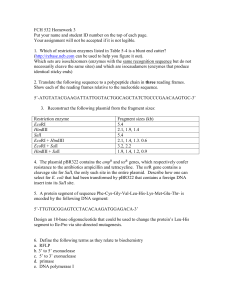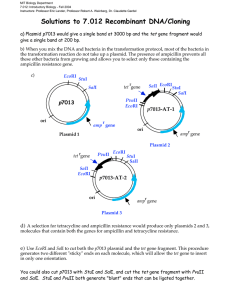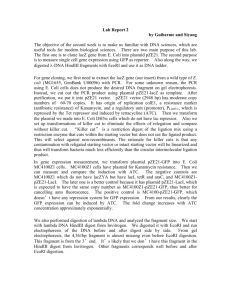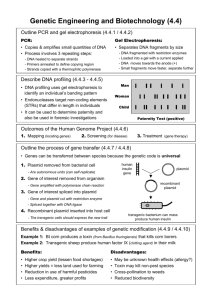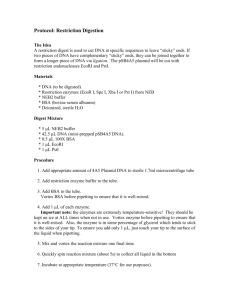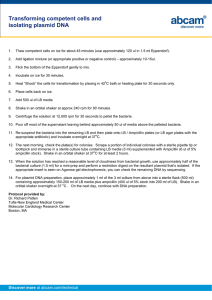Document 13478134
advertisement
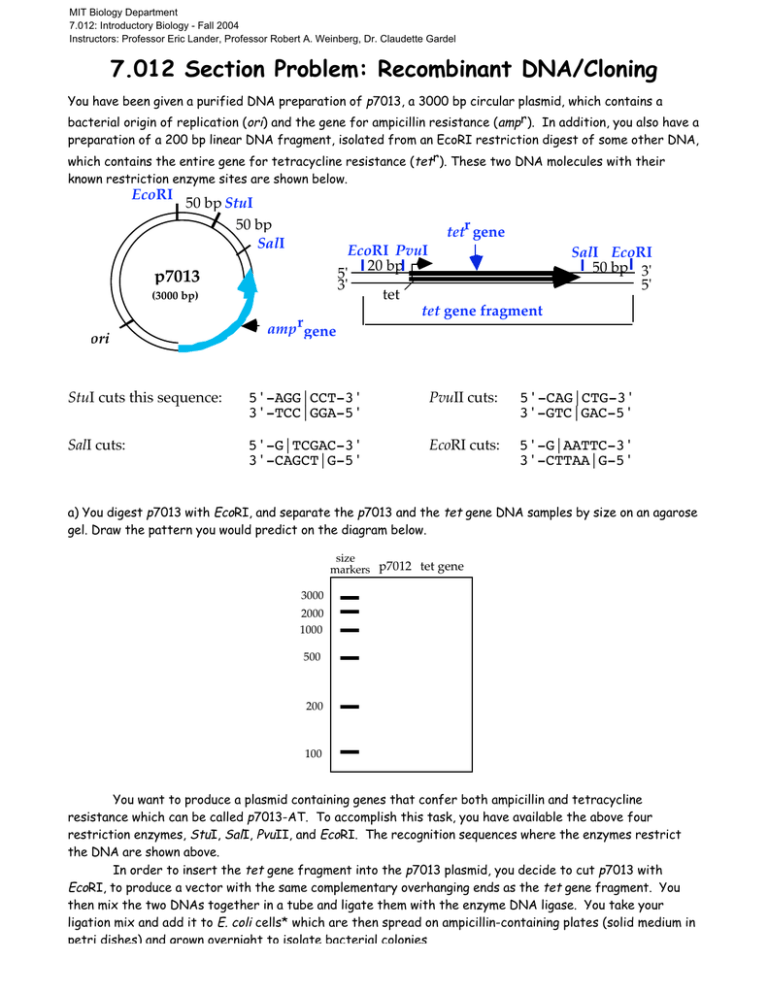
MIT Biology Department 7.012: Introductory Biology - Fall 2004 Instructors: Professor Eric Lander, Professor Robert A. Weinberg, Dr. Claudette Gardel 7.012 Section Problem: Recombinant DNA/Cloning You have been given a purified DNA preparation of p7013, a 3000 bp circular plasmid, which contains a bacterial origin of replication (ori) and the gene for ampicillin resistance (ampr). In addition, you also have a preparation of a 200 bp linear DNA fragment, isolated from an EcoRI restriction digest of some other DNA, which contains the entire gene for tetracycline resistance (tetr). These two DNA molecules with their known restriction enzyme sites are shown below. EcoRI 50 bp StuI 50 bp SalI r tet gene p7013 (3000 bp) ori amp rgene EcoRI PvuI 20 bp 5' 3' tet tet gene fragment SalI EcoRI 50 bp 3' 5' StuI cuts this sequence: 5'-AGG|CCT-3' 3'-TCC|GGA-5' PvuII cuts: 5'-CAG|CTG-3' 3'-GTC|GAC-5' SalI cuts: 5'-G|TCGAC-3' 3'-CAGCT|G-5' EcoRI cuts: 5'-G|AATTC-3' 3'-CTTAA|G-5' a) You digest p7013 with EcoRI, and separate the p7013 and the tet gene DNA samples by size on an agarose gel. Draw the pattern you would predict on the diagram below. size markers p7012 tet gene 3000 2000 1000 500 200 100 You want to produce a plasmid containing genes that confer both ampicillin and tetracycline resistance which can be called p7013-AT. To accomplish this task, you have available the above four restriction enzymes, StuI, SalI, PvuII, and EcoRI. The recognition sequences where the enzymes restrict the DNA are shown above. In order to insert the tet gene fragment into the p7013 plasmid, you decide to cut p7013 with EcoRI, to produce a vector with the same complementary overhanging ends as the tet gene fragment. You then mix the two DNAs together in a tube and ligate them with the enzyme DNA ligase. You take your ligation mix and add it to E. coli cells* which are then spread on ampicillin-containing plates (solid medium in petri dishes) and grown overnight to isolate bacterial colonies *Under special conditions, plasmid DNA can enter E. coli cells. The plasmid DNA functions as normal DNA, i.e., genes on the plasmid can be transcribed and translated. E. coli cells that have incorporated a plasmid are said to be “transformed”. b) Why is it necessary to grow the cells on plates containing ampicillin? Each bacterial cell that received a plasmid should grow up into a bacterial colony on a petri dish containing ampicillin medium. When the plasmid DNA from three of these colonies: plasmids 1, 2 and 3, are analyzed by restriction enzyme analysis with EcoRI and SalI, a distinct pattern is observed for each of the three plasmids. The patterns seen after electrophoretic separation of the DNA fragments on a size separation gel are shown below along with DNA fragment size markers: Eco RI digestion Sal I digestion size 1 3 1 2 3 2 markers 3000 2000 1000 500 200 100 c) Make a diagram for each of the plasmid molecules, 1, 2 and 3 based on the restriction patterns shown in the gel above. d) If the transformation mix (E. coli cells + plasmid DNA) had been spread on plates containing both ampicillin and tetracycline, which of the above plasmids would be able to grow? e) You would like to generate a single product, the p7013-AT with the tet gene in one unique orientation. Use any two of the available restriction enzymes to design such a procedure
